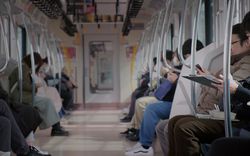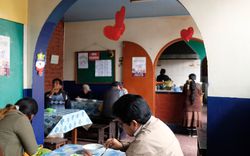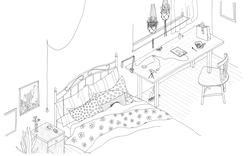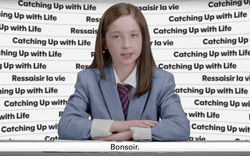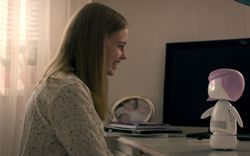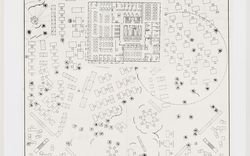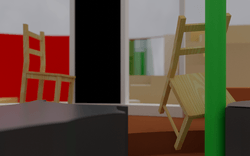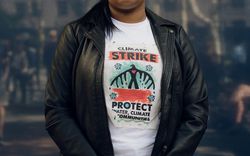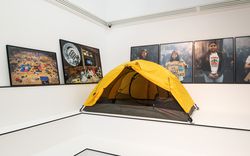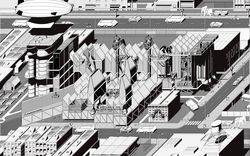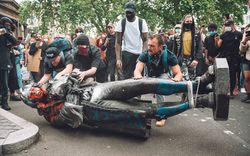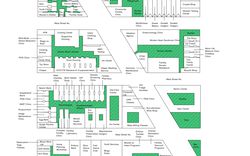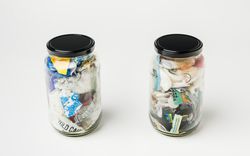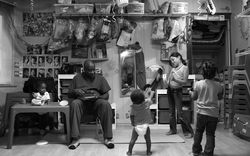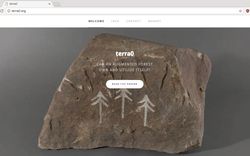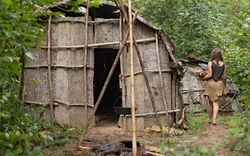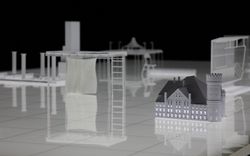Can an augmented forest own and utilise itself?
Francesco Garutti speaks with Paul Kolling and Paul Seidler about the new notion of ownership in relation to nature, and especially the forest
- FG
- An experimental prototype conceived to develop new tools to manage natural ecosystems, your terra0 project is a key case-study within the context of the A Section of Now research. It tries to explore a new notion of “property” by imagining what we could define as the attempt to set up “a forest that owns and manages itself.” What do you mean by that and how did the research for terra0 start?
- PK
- It started out as this really small project that we did in the new media class at the Berlin University of the Arts, UdK. When we studied there, where we also met, we had a one-semester assignment about the very broad topic of “nature.” Because it was a new media class, we had to deal with new technologies to some extent. I remember that Paul was really interested in the agency of smart contracts and blockchain technology, and I remember reading a text by Vilém Flusser1 about gardens in which he dismantles the division between the natural and the cultural by the terms of the garden. This was the core foundation, what we were interested in at that time.
- PS
- We were also looking into upcoming technologies and were looking a lot into the theory and the history of what, in the cryptosphere, are called “autonomous agents”; the idea that programs could gain certain autonomy through smart contracts, because they would facilitate the financial means of the administration of capital. We were interested in this as almost a dystopian vision, which led us to the question of what would actually happen if you could use these speculative systems for something more interesting, something which is not purely on a moral spectrum of good or bad, but something that just makes use of the technology and its proposed autonomy.
-
Vilém Flusser, “Von den Gaerten,” https://www.flusserstudies.net/sites/www.flusserstudies.net/files/media/attachments/flusser-von-den-garten.pdf. ↩
- PK
- From the autonomy, we then came to the concepts of ownership and personhood. We never studied law, but we read into the history of laws and terms that involved these concepts and how they came about, at least in Europe and in Germany, and we soon found out that there’s a strong link between being granted personhood and being able to own something. We diligently turned it around and said wait, if we allow or enable one thing to own another, would that also come with the premise that the thing must be granted personhood?
- PS
- There is natural personhood, which counts as every human, but there is also legal personhood, which is tied to corporations and these kinds of organizational structures. We found that there are specific cases where certain ecological systems are actually granted personhood through legislative process. It happened in New Zealand and in India, and there was then a council which could represent this entity. We were also interested in the question of why, if there is something like an organizational structure granting legal personhood to economic entities, there is nothing granting this same status to ecosystems.
- PK
- We wanted to find a test case, an example in which we could iterate our thoughts and see what the reaction is. It came back to this discourse around nature, culture, and wilderness, which in Germany is always tied to the notion of the forest. I know that here the term wilderness is completely different from the cultural connotation of wilderness in Canada, for example, but here it’s this weird non-existent, important thing which is closely tied to the Romantics; Goethe and other thinkers close to a phenomenological approach of studying nature. For us it was natural to use a system to iterate these thoughts on a forest, because it’s a heavily connotated, abstract thing. If you say “forest,” everybody has a concrete picture of it and some sort of personal connection to it in one way or the other.
We then began to ask, are we able to grant personhood to a non-human entity like a forest or a whole ecosystem by enabling it, technically, to own something? In this case, the forest would own itself. We developed this concept where a forest accumulates capital by appropriating exploitational mechanisms, which is normally done by third parties, and then uses this capital to buy its own ground, its own land.
- PS
- The economic system of the forest we proposed is really simple and almost dull. It’s essentially an automated system with a program that could selectively sell the rights to cut down certain trees, and that would gain financial means through this; so sort of paying out the initial investors of the project. People would buy into the project, almost like lending the forest money, and then this system would pay these people out with a small profit over a certain number of years.
- FG
- Basically, drones and satellites would constantly check the growth of the forest, providing documentation to assess how much wood can be harvested from it, and then sold to reactivate the cycle. The human action would be required only to activate the work chain. It is a simple and at the same time conceptually delicate project.
- PK
- Yes. And it was a really populist project, because either people loved it or absolutely hated it. We presented it in various exhibitions and talks, and people were like “this is a really brilliant idea to set up new types of natural preservation zones, how to present ecosystems in the legal sphere better, and also in the technosphere.” But then there was a really interesting anthropomorphizing moment where other people said, it’s absolutely cruel to force a forest to cut down its own trees. People perceived it as self-harm, which I think is interesting and helpful for us to actually communicate where the exploitation happens and that there’s also always exploitation happening if something exists in a capitalist system. Even if the state pays for a natural preserve and the trees are left alone, this is done because of financial reasons, because somebody did the math and found that it creates recreational value for the people, thus increasing the production force of labour, etc. Accepting the reality as what it is—a hyper-complex system of dependencies—was a really important thing for us to communicate straight from the beginning.
- PS
- I think this is a really interesting point because it also showed how much people romanticize forests and don’t think that they’re integrated in some sort of production. It’s a really strange notion that they are untouched. In reality, there are untouched forests, but they’re really small. All of these forests that are considered the “original nature,” if they still exist, are used for wood production. So, it’s this bizarre picture which doesn’t acknowledge the reality of things.
- PK
- Another important aspect, of course, was the term of property and the ownership of land. In Germany, we are lucky enough to have certain types of laws which determine what you have to do if you have a forest. You’re not allowed to close it off from the public, and you have to maintain paths through it. People were also thinking, “They want to tie a blockchain to a forest, and create a hyper-exploitation of this untouched ecosystem, and now it’s privately owned.” But if you look at privately owned forests, which the vast majority of forests in Germany still are, you clearly see the old royal houses of the medieval times and the family names.
There is also a saying in Germany, “Man kauft kein Wald, man erbt ihn,” that roughly translates to “and you don’t buy a forest, you inherit it.” There’s something about the ownership of land, which is tied to this old system of power, that is completely accepted. - FG
- This point of the forest as an apparently totally wild and natural element, while we know that it’s a constructed entity, is interesting. We developed a project in 2011 curated by Dan Handel about this subject. Was the forest the direction you imagined this project taking from the beginning, or did this series of thoughts and the relationship between personhood and ownership consider other options? For instance: Can we test it on the city? Can we test it on the object? Can we purely stay in a domestic environment?
- PK
- The forest is definitely an important metaphor. The forest was the first thing that came to mind, but we also discussed if we should go in the direction of agriculture. We decided that the forest is interesting because it’s this complex narrative, but it also has a productive value with very little human interaction or involvement. So, it’s a nice thing to build upon, ecological growth, and then to see what kind of impact it has in financial terms. But we had a discussion if we should just do it with a field, for example, or if we should try to cast it onto houses. I think now we’re feeling confident and just following the project in one direction and then using it, or in the best case, having other people use it as a metaphor to cast it onto different subjects.
- FG
- In your work, you talk about the different levels of complexity or potential actions and phases the project could shape into and become. What does it mean for you to expand this project?
- PK
- Right now, we are more interested in creating a prototype or blueprint approach, designing a system that other people in other places can use for similar cases, and therefore there’s this aspect of growth in it. Other people could adapt it, use it, remix it.
- PS
- I think the general trajectory that this project has had comes about also from a really gentle reading of artificial intelligence. A lot of these early thoughts were inspired by people in the AI field who think of AI as something that actually can do something. And scientists are really detached from the real level of AI at the moment, so these ideas are essentially coming more from science fiction. A lot of these levels of complexity that we map out with terra0 come from this idea of production for the sake of production, forest for the sake of forest, and so on.
This is something we reflect on critically in the things we’re doing now, because we feel we need to deconstruct this optimistic vision of AI. We need to see what AI is actually used for and how it actually relates to extraction mechanisms, how these automated functions of AI are just smoke and mirrors for extracting labour. We would like to have some organizational structures which, like protocols, can automate the direct influence of people, and that people can in turn contribute to these protocols rather than having an abstracted form of artificial intelligence giving them orders.
- FG
- As you said, this is kind of a prototype. It’s a statement, and to me it brings to a visual level the crucial discourse on property and law today. I strongly think that a contribution to space-making should pass through a deep and strong reflection today about what you’re saying: what is property, but also what is the legal framework within which we are able to operate? And that’s why I’m also interested in the fact that you are basically developing this research and prototype within a realm in between art practice and legal studies.
Art of course lives within a specific context, a framework with its own economy and scale of values, but of course also one within which it’s possible experiment in freedom. Have you been thinking about how your research could be proposed or discussed with legal theorists, ecologists, or politicians in charge of the management of natural parks or resources? - PK
- For me personally, it’s important that terra0 is an art piece. It used to be that I justified it in a way that art gives you quite some freedom. You can do things which you wouldn’t be allowed to do or which wouldn’t be appropriate to do if it wasn’t an artwork. But then throughout the years, never being funded by an institution, always having these basic problems of financing your own research of a non-profitable project, we were also in contact with a lot of people who were interested in the purely economic usage of this project or framework. And we were also offered quite substantial amounts of money to shift this to become a forestry project.
Recently, we have been thinking of it in terms of a land art project, which we never really did. We never really looked into the history of land art, because it was this very specific time when Paul and I weren’t born yet, and it also ended and wasn’t really picked up as a genre in art. And I think there are good reasons for this. We are currently thinking, could this be a new type of land art? And what would the new type be? And how would it need to be distinguished from the traditional land art of the 1970s, for example? But I think for us it’s also really useful to think in these terms to justify what we’re doing.
- FG
- What is the direction you’re imagining taking it now?
- PK
- One of the shifts from when we started the terra0 project to what we are working on now is definitely about value production. From a core conception, we do think that an ecosystem nowadays, if it exists, if it’s biologically diverse and sustainable, has already done what’s needed to justify its existence. The first concept was about drawing up a system of artificial intelligence—or whatever you want to call it—and filling it with data, hoping the amount of complexity, being derivative in the future, is higher from what you’re putting into it at the beginning. Our new concept really considers time spans and intervals. Humans have a really strong perception of time, whether it’s a lifespan or a day or a week, but these intervals don’t really apply to ecological development. We have been starting to think in terms of something much longer than a human lifespan.
It’s really hard to think of a technology that surpasses and evolves over such a long time. You could talk about communities as a technology in this way, because they do this very well—people talking to each other and engaging in one subject, and then passing on this information to future people involved in the project. The next concept will definitely be more focused on the idea of swarm intelligence rather than artificial intelligence, and will also be about creating a long-term engagement of people in an ecosystem in one way or another.
terra0 website. Screen capture. Courtesy of terra0, Berlin © terra0.org
This article is published as part of our ongoing Catching Up with Life project.

